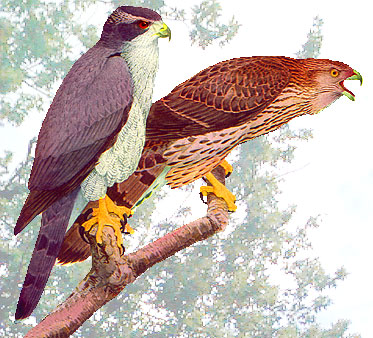
Northern Goshawk Astur atricapillus atricapillus
 Left, adult; right, immature
Left, adult; right, immature
|
GENERAL DESCRIPTION:
Length: male, 22 inches; female, 24 inches. Spread of wings, 43 to 47 inches.
About the same proportions as the Sharp-shinned Hawk and Cooper's Hawk. Color above, bluish-slate; below, white.
|
OTHER NAMES:
American Goshawk; Blue Hen Hawk; Blue Darter; Partridge Hawk; Dove Hawk; Chicken Hawk.
|
ADULTS:
Top and back of head, black, the white under surface of the feathers much exposed on
back of head; a broad conspicuous white stripe over eye extending to back of head, finely streaked with black; rest of upper parts, uniform bluish-slate; tail, darker and barred by five broad faintly defined bands of blackish and tipped with whitish; primaries, dusky slate; lores and cheeks, dull grayish-white; lower parts, white, everywhere except on throat and lower tail-coverts traversed with numerous narrow bars of slaty color, more broken on the breast, more regular on flanks and thighs; chin, throat, and cheeks with very fine black shaft lines; these shaft lines also evident on rest of under parts;bill, dark-bluish horn color; iris, red; cere, legs, and feet, yellow; claws, black. |
YOUNG:
Young: Above, dark brown, the feathers margined with rusty, this color changing on neck and shoulders to whitish or dull buffy; wings and tail, barred with dusky and light brown; under parts, yellowish-white thickly marked with lance or drop-shaped dark brown streaks; tail
more strongly barred than adult's; a broader white tip; cere and feet, duller yellow; iris, yellow; bill, more brownish.
|
NEST:
Usually in a conifer at a great height and in the most inaccessible depths of evergreen woods; constructed of sticks, twigs, weed stalks, and leaves, and lined with strips of bark, grass, and hemlock twigs. |
EGGS:
2 to 5, pale bluish-white, sometimes faintly spotted with pale buffy-brown but normally immaculate. |
| |
 Distribution: Distribution:
North America; breeds from northwestern Alaska, northwestern Mackenzie, central Keewatin, and northern Ungava south to Michigan and New Hampshire, and in the mountains south to Pennsylvania and New Mexico; winters from Alaska and the southern Canadian Provinces south to northern Mexico, Texas, Oklahoma, Missouri, Indiana, and Virginia; accidental in England. |
It is fortunate for the American hen that the Goshawk resides mostly north of the United States, migrating southward only in winter when its toll from the poultry yard is necessarily limited because the birds are confined to their houses. It is the most destructive of the Hawks to game birds, the Ruffed Grouse suffering particularly from its depredations.
Swift in attack, its flight is even and thus an easy target for hunters; its death is often accomplished with a rifle in the hands of a fair shot. Like most Raptores, hunger deprives it of caution. It will follow a hunter and snatch a wounded bird almost from beneath the hunters feet, although this performance may mean its own destruction. Unless the adult is hungry, young Goshawks are more audacious than their elders and because of their brownish plumage their deeds are frequently attributed to the harmless Red-tail.
The Goshawk is the most symmetrical and clean-cut of all its family not excepting even the Peregrine Falcon. Its destructiveness cannot obliterate the appreciation its prowess arouses.
The Western Goshawk (Astur atricapillus striatulus) differs in having the markings of the under parts much more numerous; the upper parts are darker and incline to blackish on the back. This form inhabits the Arctic parts of the Pacific coast and breeds from Alaska south to the Sierra Nevadas of California. In winter it may be found in southern California and east
to Colorado.
| Hawk-like Birds | Home | Bird Classifications |
|


 Distribution:
Distribution: